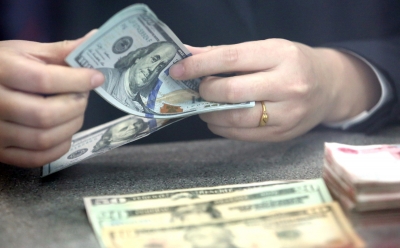Food Inflation
The Indian economy faces a multifaceted challenge as food prices continue to rise, exerting significant pressure on households and policymakers alike.
While the virus was still present on the stainless-steel surface after seven days, on the 10-euro banknote, it took only three days to completely disappear.

Photo: IANS
While the fear of getting Covid infection from banknotes and coins has driven much more contactless payments during the pandemic, researchers say the risk is far too less.
Experts at the European Central Bank, in collaboration with researchers at Ruhr-Universitat Bochum in Germany, wanted to clarify how long do coronaviruses remain infectious on banknotes and coins? Is it possible to become infected through contact with cash?
The team treated various euro coins and banknotes with virus solutions of different concentrations and over several days observed how long infectious virus was still detectable. A stainless-steel surface served as a control in each case.
Advertisement
While the infectious virus was still present on the stainless-steel surface after seven days, on the 10-euro banknote, it took only three days to completely disappear.
For the 10-cent, 1-euro, and 5-cent coins after six days, two days, and one hour, respectively, no infectious virus was detectable.
“The rapid decline on the 5-cent piece is because it’s made of copper, on which viruses are known to be less stable,” explained Daniel Todt, from the varsity’s Department of Molecular and Medical Virology.
The study was published in the journal iScience. The researchers also developed a new method to study how well the virus is transferred from a surface to the fingertip.
They contaminated banknotes, coins, and credit-card-like PVC plates with harmless coronaviruses and, under high-security conditions, also with SARS-CoV-2.
These surfaces were then touched, while still wet or when already dried, by test subjects with their fingertips or, in the case of SARS-CoV-2, with artificial skin.
Cell cultures were then inoculated with the viruses adhering to the fingertips. This allowed the researchers to determine the number of transmitted virus particles that were still infectious.
“We saw that immediately after the liquid had dried, there was practically no transmission of infectious virus,” Todt said.
“Under realistic conditions, infection with SARS-CoV-2 from cash is very unlikely,” he added.
Smear infections via surfaces are almost non-existent. The current study was conducted with the Alpha variant of SARS-CoV-2 in addition to the wild-type variant.
“We assume that other variants, such as the currently predominant Delta variant, also behave similarly,” said Eike Steinmann, Professor at the varsity.
Advertisement